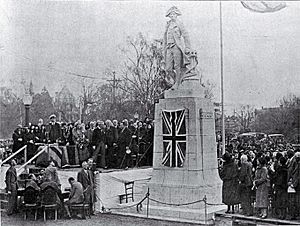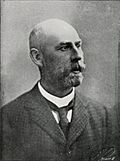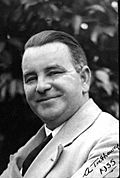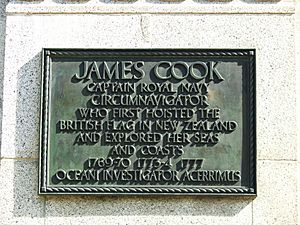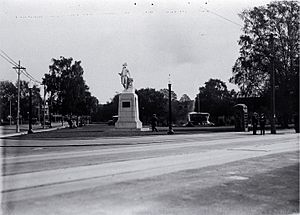Statue of James Cook, Christchurch facts for kids
Quick facts for kids Cook Statue |
|
|---|---|
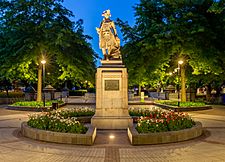 |
|
| Artist | William Trethewey |
| Year | 1932 |
| Type | Carrara marble |
| Location | Christchurch, New Zealand |
| 43°31′40.9″S 172°38′8.1″E / 43.528028°S 172.635583°E | |
| Owner | Christchurch City Council |
The Cook Statue in Victoria Square, Christchurch, is a special monument. It celebrates the three amazing journeys of James Cook to New Zealand. This statue was carved by William Trethewey. It was officially revealed on 10 August 1932 by the Governor-General, Lord Bledisloe. A kind and wealthy man named Matthew Barnett (1861–1935) gave the statue as a gift.
Contents
How the Statue Was Made
Matthew Barnett became very rich through his business. Even though he was wealthy, he wasn't part of the "high society" because his business was seen as different back then.
In 1928, Matthew Barnett decided to fund a competition. He wanted to find the best design for a statue honoring James Cook's trips to New Zealand. William Trethewey (1892–1956) won this competition. This was the biggest project he had ever worked on!
A huge 12-ton block of Carrara marble was brought in for the statue. This project made Trethewey quite famous. He even appeared on Movietone News, which was like the news on TV back then.
At first, people thought about putting the statue near the Avon River in Victoria Square. But by late 1929, Barnett preferred a spot at the corner of Armagh and Colombo Streets. This is in the south-east part of Victoria Square.
Barnett explained that this spot would let people see the statue from many directions. You could even see it from far down Colombo Street! This is where the statue was first placed. Barnett lived only a few blocks away from Victoria Square.
Barnett first offered £500 for the statue. He hoped others would help pay the rest. But later, he decided to pay for the whole thing himself. He gave an extra £1,500, or "as much more or less as might be required."
The Unveiling Ceremony
Dan Sullivan, who was the Mayor of Christchurch at the time, invited the Governor-General, Lord Bledisloe, to the ceremony. Lord Bledisloe agreed, and the Cook Statue was officially revealed on 10 August 1932.
In his speech, the Governor-General talked about New Zealand's early history:
In the early history of New Zealand there are three important moments. First, its discovery by James Cook in 1769. Second, when Christianity arrived with Samuel Marsden in 1814. And third, when it became part of the British Empire with the Treaty of Waitangi in 1840. Without Cook's first journey, the other two would likely not have happened.
The mayor, Dan Sullivan, spoke next. He mentioned that Cook came from a humble family and started as a common sailor. Sullivan said he had a special interest in working-class people. Then, Matthew Barnett spoke. He talked about the difficult economic times, as New Zealand was going through the Great Depression. Many people were struggling. He explained that he had planned the gift three years earlier when times were better. To help, he gave the mayor a cheque for 100 guineas for the Mayor's Fund.
The Cook Statue has two special plaques. One plaque lists Cook's journeys:
James Cook, Captain, Royal Navy, circumnavigator who first hoisted the British flag in New Zealand and explored her seas and coasts, 1769–70, 1773–4, 1777
The second plaque has a Latin phrase: "Oceani investigator acerimus." This means "A most eager investigator of the ocean."
Matthew Barnett's wife, Mary, passed away in 1931, before the statue was revealed. Matthew Barnett himself died in January 1935, just over two years after the statue was unveiled. There are white marble chips on their grave. These are pieces left over from when the Cook Statue was made.
Moving the Statue
In 1989, Victoria Square changed a lot. Victoria Street, which used to cut through the Square, was closed off. A new hotel, the Crowne Plaza Hotel, was built. The Square also got a new design. During these changes, the Cook Statue was moved to its current spot, which is more in the center of the square.
Protecting Our History
The Cook Statue is officially recognized as a Category II heritage item by Heritage New Zealand. This means it's an important historical place. It was registered on 26 November 1981. The statue is important because it shows William Trethewey's great work. It's also one of many monuments to Captain Cook in New Zealand, and it's a well-known landmark in Victoria Square.
See also
 In Spanish: Estatua de Cook para niños
In Spanish: Estatua de Cook para niños


